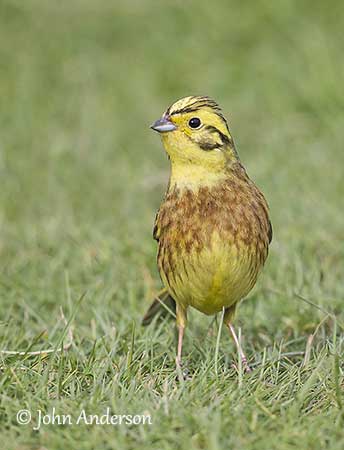
Fr: Bruant jaune
Ang: Yellowhammer
All: Goldammer
Esp: Escribano Cerillo
Ita: Zigolo giallo
Nd: Geelgors
Sd: gulsparv
Photographers:
John Anderson
John Anderson Photo Galleries
Didier Buysse
Vision d’Oiseaux
Steve Garvie
RAINBIRDER Photo galleries & Flickr Rainbirder
Eugène Montocchio
Galerie Photos Nature & Chez Gégène
Otto Plantema
Trips around the world
Text by Nicole Bouglouan
Sources:
HANDBOOK OF THE BIRDS OF THE WORLD Vol 16 by Josep del Hoyo- Andrew Elliot-David Christie – Lynx Edicions – ISBN: 9788496553781
THE COMPLETE BOOK OF BRITISH BIRDS – Written by “Royal Society for the Protection of Birds” experts - Préface de Magnus Magnusson - Michael Cady- Rob Hume Editors - ISBN: 0749509112
THE HANDBOOK OF BIRD IDENTIFICATION FOR EUROPE AND THE WESTERN PALEARCTIC by Mark Beaman, Steve Madge - C. Helm - ISBN: 0713639601
ENCYCLOPEDIE DES OISEAUX DE FRANCE ET D’EUROPE – de Peter Hayman et Rob Hume - Flammarion – ISBN : 2082009920
Birds of Britain - The Web Magazine for Birdwatchers
New Zealand birds and birding (Narena Olliver)
What Bird-The ultimate Bird Guide (Mitchell Waite)
Wikipedia, the free encyclopaedia
Yellowhammer
Emberiza citrinella
Passeriformes Order – Emberizidae Family
INTRODUCTION:
The Yellowhammer is a bright-coloured passerine. The breeding male exhibits bright yellow and chestnut plumage. This species is known for its songs locally described by several words that only recall the rhythm, and are imitative of the song.
It is widespread throughout much of Europe, with some populations only partially migratory or dispersive after the breeding season. It frequents farmland, edges of woodlands, heaths and wooded pastures.
The Yellowhammer is threatened by habitat destruction and its population is suspected to be declining, but currently, the species is not globally threatened.

DESCRIPTION OF THE BIRD:
Biometrics:
Length: 16-17 cm
Wingspan: 26 cm
Weight: 20-36 g
The Yellowhammer male in fresh plumage (September/November) has yellow head with dark lateral stripes bordering the yellow crown. The cheeks are brownish, surrounded by darker edges on ear-coverts and malar area.
The upperparts are warm brown with blackish streaks, but rump and uppertail-coverts are rufous-chestnut and less streaked. On the upperwing, the edges of the primaries show yellow tones, whereas the tail has some white on the outer rectrices.
On the underparts, chin and throat are pale yellowish. Rest of underparts is yellowish with dark streaks on breast and rear flanks. We can see an olive-rufous breastband, with more rufous on breast sides and upper flanks.
In worn plumage (May/August), the head is more yellow with a dark pattern sometimes restricted to narrow blackish streaks above the supercilium, but very faint above the eye. There is a dark greenish eye stripe curving down the rear of ear-coverts to lower rear corner of cheeks. The nape is yellow and greenish-grey, and the upperparts are brighter than in autumn. Below, the breast is mostly rufous.
The bill is blue-grey. The eyes are dark brown. Legs and feet are brownish.
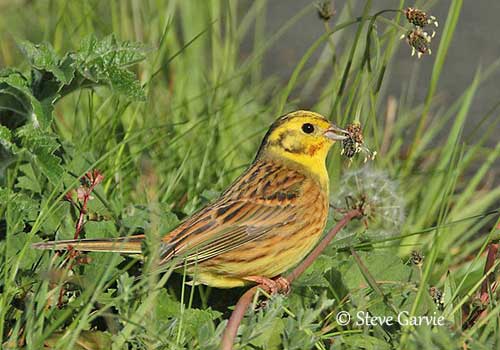
The female in fresh plumage shows similar plumage pattern, but she is duller and paler overall. The head pattern is more prominent and more olive and brown.
In worn plumage, she has less yellow on head and more streaked crown, and grey-green head sides. The upperparts show duller ground colour, whereas the underparts are paler yellow, with more marked greyish-black streaking on breast and flanks.
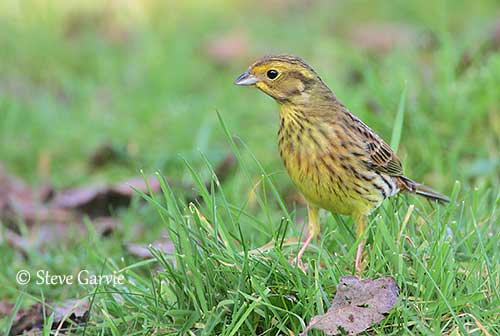
The 1st winter has almost wholly brown head. It lacks the supercilium, and has more diffuse streaks on crown. The underparts are buff-white with faint yellow tinge.
The 1st winter male resembles adult female, whereas the 1st winter female is duller than adult in similar plumage.
The juvenile has heavier streaking on the underparts, and duller colours than adult female. It has an indistinct supercilium, and broader dark streaks on mantle and scapulars.
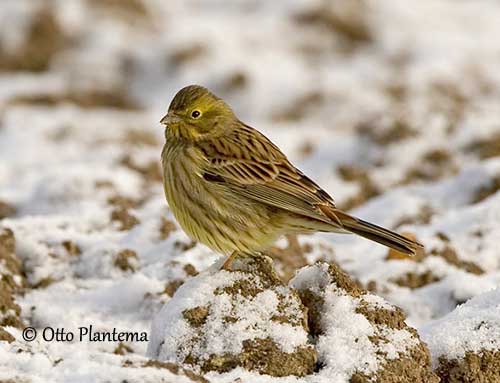
SUBSPECIES AND RANGE:
The Yellowhammer has three subspecies.
E.c. caliginosa is found in Ireland, Isle of Man and Britain, S to Wales and N and W England.
In this race, the male is slightly darker with brighter colours and heavier streaking than nominate.
This race was introduced in New Zealand where it is common in open country.
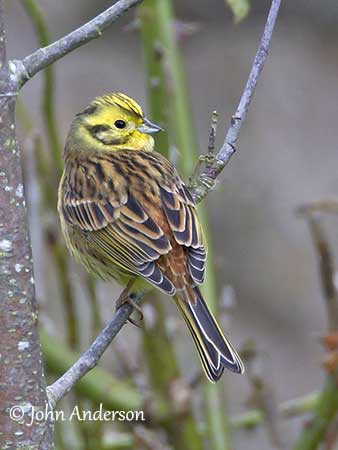
E.c. erythrogenys occurs E to SC Siberia and NC Mongolia. There are isolated populations in E Black Sea coast region and Caucasus. Some of them migrate S to Turkey, Levant, Iraq, Iran and C Asia, a few to N Italy.
This race is paler and less streaked than nominate, with greyish hindneck and shoulders, and brighter chestnut on breast and flanks.
E.c. citronella (described above) is found in Fennoscandia and SE England S to N Iberia, S France and Italy, and E to extreme NW European Russia, Poland, Czech Republic, Hungary and Balkans.
HABITAT:
The Yellowhammer usually breeds in open woodlands, heathlands, scrub, cultivations and orchards, but it avoids the dense forest. It can be seen between 600 and 900 metres of elevation.
In the southern part of the range, it frequents forest clearings up to 2000 metres of elevation, favouring areas with close cultivated fields on high slopes.
In the northern part of the range, it can be seen at the edge of forest tundra and true tundra.
It frequents mostly agricultural areas during winter, foraging in unharvested cereal fields, pastures, orchards and forest edges.
During the autumn, the flocks roost in scrubby or marshy areas.
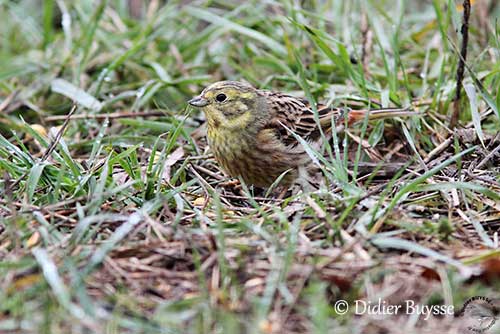
CALLS AND SONGS: SOUNDS BY XENO-CANTO
The Yellowhammer usually sings from perch such as treetop of fence post. The contact call frequently giver by both adults is “twick” or “twitic”. A thin “see” is given as alarm call. A metallic “tzit” is commonly given from the ground or in flight. A liquid “trrp-trrp” is heard from the flying flocks.
The distinctive song is a series of rapid, high-pitched insect-like notes, followed by a thin wheeze “zi-zi-zi-zi-zi-zi teeeeeeeeeee” often described as “little bit of bread and no cheeeese”. In E Europe, the song is mostly “tee-tee-tee-tee-tee-tee siiiiiiiiiiiiiiiiiiiiii”
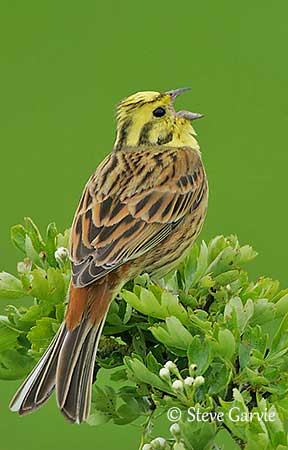
BEHAVIOUR IN THE WILD:
The Yellowhammer feeds primarily on seeds, both of grass and cereals of various species. Seeds are taken on the ground, but in autumn, the birds can be seen perched on cereal stems to obtain grains. It often hops on the ground with crouched posture.
It also consumes invertebrates, especially during the breeding season. It takes grasshoppers, moths, caterpillars, flies, aphids, beetles, bugs, cicadas and spiders. The young are mostly fed on insects.
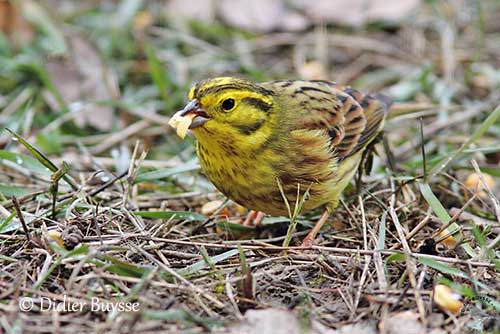
The Yellowhammer male becomes aggressive while establishing the territory. During the courtship, it pursues a potential mate in a rapid, twisting aerial display. The females often prefer to copulate with the most colourful males. They are monogamous, but numerous extra-pair copulations are reported.
Once the pair is formed, both mates can be seen feeding together. During the egg-laying period, the male stays close to its mate, probably performing mate-guarding. Only the female develops an incubation patch and incubates the eggs. But the young are fed by both parents.
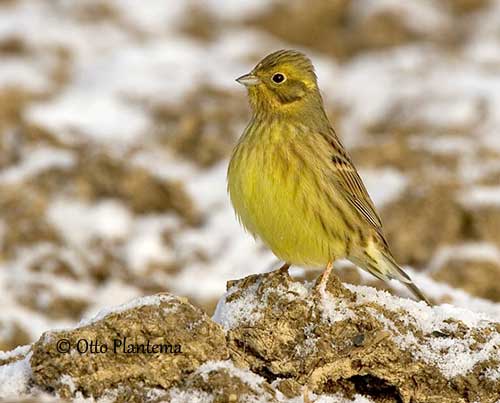
The Yellowhammer is sedentary and partially migratory. Most European populations winter within their breeding range, and only the northernmost birds migrate S after breeding.
The Asian populations are more strongly migratory and spend the winter in Iraq, Iran and S Central Asia. It is a resident species in the UK, with more restricted range in Scotland than in the rest of the British Isles. They may form small flocks outside the breeding season.
The Yellowhammer often performs long, circular flight, and returns to a point close to where it took off. In flight, it alternates several rapid wingbeats with short glides.
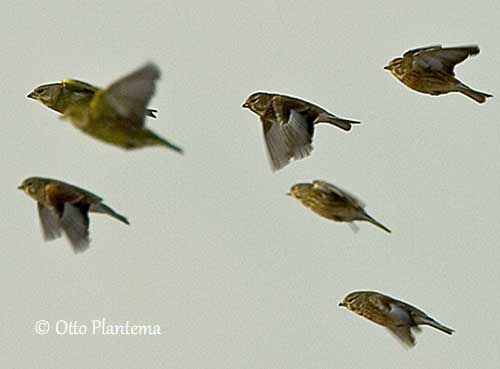
REPRODUCTION OF THIS SPECIES:
The breeding season starts usually in April, but later at higher latitudes, with late broods in September. But in W and C Europe, the first brood often starts in May. In New Zealand, the breeding season takes place from October to March.
This species produces 2-3 broods per season.
The nest is built by the female, on or near the ground. It is made with material found in the vicinity of the nest-site. The nest is made with dry grass and plant stems, leaves and some moss. The cup is lined with rootlets, soft grass and sometimes animal hair.
It is generally placed among grass, at base of clump of tall grasses, bush or small tree, or sometimes protected inside a thorny bush.
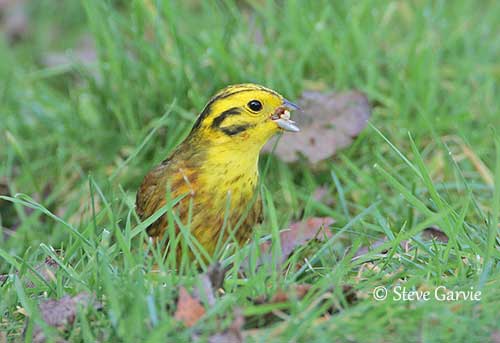
The female lays 2-6 whitish to pinkish-white eggs with fine dark spotting. She incubates alone during 12-14 days, and broods the chick while the male brings food to the nest. Then, both parents feed the chicks, mainly on invertebrates. They fledge 11-13 days after hatching.
In Urals and W Siberia where the breeding ranges overlaps, the Yellowhammer and the Pine Bunting frequently hybridize, despite the differences in male plumages. The chicks show a variety of mixed characters, and mainly in males.
PROTECTION / THREATS / STATUS:
The Yellowhammer has very large range in which it is locally common or very common, but scarce in some regions.
This species is threatened by habitat destruction and reduction in cultivation of cereal crops.
The European population is estimated to number 54,000,000/93,000,000 individuals (2004), and the global population is roughly estimated at 73,000,000/186,000,000 individuals. This population is suspected to be declining, due to the previous threats.
But the Yellowhammer is currently evaluated as Least Concern.
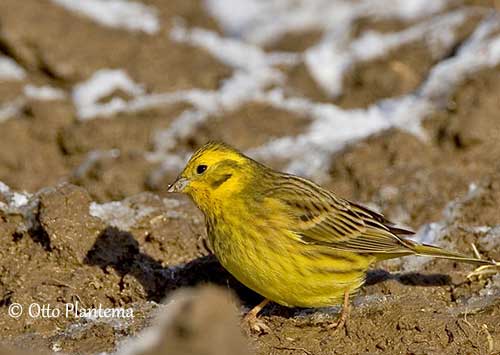
Photographer's note:
A male perched on a Dandelion stalk feeding on Ribwort Plantain seed